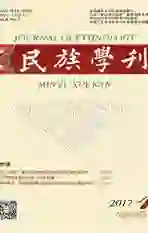A Research on the Artistic Characteristics of the Headdress of the Paiwan in Taiwan
2017-03-12XuQiangLiuYang
Xu+Qiang++Liu+Yang
DOI:10.3969/j.issn.1674-9391.2017.01.08 Abstract:Among Taiwans aboriginal tribes, the Paiwan has the most exquisite decorative adornments on their costumes. In addition to the decorations of their clothing, they also give importance to the decorations on their headdress. Every group designs different headdresses according to social status— this also reflects the cultural identity of the group. The headdress is an external marker of ethnic culture, the carrier of ethnic customs and aesthetic consciousness, and it helps to transmit and promote traditional culture.
The Paiwan people have various forms and shapes of headdresses which are designed freely according to the designers artistic inspiration. However, the snake form can only be used by tribal leaders. The headdresses are mainly made from natural materials, such as eagle feathers, animal hides, animal teeth, horns, flowers, grasses, seeds, colored glazed beads, shells, ceramics, metal, etc. However, eagle feathers, animal hides, animal teeth, horns, and colored, glazed beads can only be used by leaders and nobles; common people are strictly forbidden to use these materials.
The social organization of the Paiwan and their festivals and sacrificial ceremonies determine their various headdresses. The headdresses and head bands of the Paiwan are made mainly from black or red flannel; the shape and the use of the materials reflect hierarchical differences. Headdresses can be divided into those of leaders, nobles, warriors and commoners.
The form of the Paiwan peoples headdress consists of strong layering; each is decorated with a variety of materials, creating a three-dimensional effect. The decoration of a moulded cottonmouth snake on the head band reflects the peoples snake worship, and also the groups aesthetic consciousness and worship of ancestors.
The decorative expertise and complex working process reflect the Paiwan peoples superb skills in weaving. The materials used for the headdresses of Paiwan people are mostly derived from nature, and strongly reflect regional characteristics.
Totem worship is characteristic of Paiwan religion, and it is a form which combines the worship of nature and ancestors. The forms of animals reflect the psychology of Paiwan people s original worship in which they depended on getting along with nature, and in which they placed their hopes in Totem worship.
The Paiwan have many myths, which is one of the characteristics of their culture. The forms of the sun and cottonmouth snake, which decorate the headdresses of the leaders, reflect that the sun is the creation of life. Chamilia beads are regarded as a class symbol by the Paiwan people, and have a protective function.
The first child of a Paiwan family, no matter whether it is a boy or girl, has the right to inherit property of his/her paternal or maternal home. One should also notice that the colors, materials, and forms of the headdress of Paiwan man and woman in the same class are the same.
In summary, the shapes and forms of the Paiwan peoples headdresses vary. They reflect the Paiwan peoples unique aesthetic consciousness, and embody the Paiwan peoples excellent techniques in traditional decorative handwork. The use of colors represents the Paiwans optimistic attitude towards life. Materials are derived from nature, which reflects the groups harmonious relationship with the nature. Headdresses are not only an external form of decoration, but they also have profound cultural connotation and national consciousness. The class system, taking nature as beauty, worshiping ancestors, their myths, and the equality between men and women reflected in the headdresses of the Paiwan people indicate the Paiwan peoples inheritance of tradition, natural worship and pursuits in life. The study of the artistic features and cultural connotation of the headdress of the Paiwan people can help to protect Paiwan traditional adornment technique, and enrich the requirement of diversity in headdress design.
Key Words:Paiwan people; headdress; characteristic; culture; inheritance
References:
Gu Yang. tanwan shaoshu minzu—paiwan (Ethnic Minorities in Taiwan—Paiwan) .Beijing: taihai chubanshe, 2008.
He Mianshan. mantan taiwan yuanzhumin fushi xingzhi ji tedian (On the Shape and Characteristics of the Costume of the Aborigines in Taiwan).In Ethno-National Studies in Gansu ,2005(3-4).
Lv Ping. jinxiao yaozu nvxing toushi de yishu tezheng yu shenmei tushi (Artistic Characteristics and Aesthetic Pattern of Headdress of Females of the Yao in Jinxiu). In Journal of Silk,2013(11).
Peng Weibin. taiwan yuanzhumin shuzi chuangsheng shenhua de wenhuashi yiyi (The Cultural History Significance of the Taiwan Aborigines Life Creation Myth). In Cultural Communication between Fujian and Taiwan,2009(4).
Suo Wenqing.taiwan shaoshu minzu fushi gaishuo (Brief Introduction on Ethnic Minority
Costumes in Taiwan) . In minzu fushi yu wenhua yichan yanjiu—zhongguo minzuxue xuehui 2004 nian nianhui lunwenji( Research of Ethnic Costumes and Cultural Heritage—Collection of Papers Presented in the 2004 Annual Meeting of the Chinese Society of Ethnology).
Tu Yijia.chuantong tuteng wenyang zai xinadai fushi zhong de yunyong ji yanbian(The Use of Traditional Totem Patterns in Modern Dress and Its Evolution) . In Journal of Textile Research,2012(5).
Xu Qiang. taiwan alishan zouzu fushi yishu tezheng yanjiu (Research on Artistic characteristics of the Zou Tribes Costume in Alishan of Taiwan). In Journal of Silk,2016(12).
Xu Qiang. taiwan paiwanzu fushi wenyang de wenhua neihan jiandu (Interpretation of the Cultural Connotation of the Taiwan Paiwan peoples Clothing Patterns) .In Journal of Textile Research,2016(12).
Xu Qiang. taiwan yuanzhumin fushi tezheng yanjiu (Research of the Characteristic of the Costume of Taiwan Aborigines) . In Journal of Wuhan Textile University.2015(5).
Zhang Ben. qiangzu toushi yangshi de diyuxing chayi fenxi (Analysis on Regional Differences of Headwear Style of the Qiang Nationality) . In Journal of Silk,2013(11).
